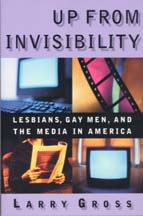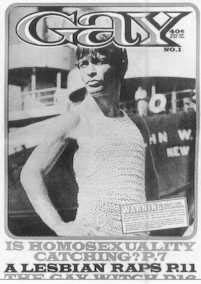 |
|
Media Matters Up from Invisibility: Lesbians, Gay Men and the Media in America by Larry P. Gross, Columbia University Press, 2002 $18.50  Publishers love to use the word "media" in their titles because it appeals to a broad spectrum of potential book buyers, but this practice often creates a major challenge for a responsible author who tries to live up to such a title.
Publishers love to use the word "media" in their titles because it appeals to a broad spectrum of potential book buyers, but this practice often creates a major challenge for a responsible author who tries to live up to such a title.
What exactly does "media" include? Can an author use the term, in good conscience, when the book only talks about, say, newspapers and television? Or is that author also duty-bound to include material about magazines, radio, and film? And what about books, music, the Internet, public relations, and advertising-aren't they all part of "media"? Too many books imply, at least in their titles, that they cover the waterfront, so to speak, and provide substantive content about these topics that all fit under the umbrella created by the term "media" but then ultimately disappoint the reader by concentrating on only two or three of them. This is not such a book.
Gross next moves on to early journalistic ventures. He gives due credit to such pioneering periodicals as the typewritten Vice Versa, founded in Los Angeles in 1947, and the monthly magazine ONE, distributed nationally from 1953 through 1969. Gross also documents how mainstream publications, such as the New York Times and Life magazine, worked steadfastly against the fledgling Homophile Movement. By the 1970s, other forms of media were influencing how Middle America was viewing gay men and lesbians. Gross duly documents these roles, discussing both the steps backward, such as the 1970 film The Boys in the Band that communicated that gays were universally lonely and bitter, and the steps forward, such as the 1971 segment of "All in the Family" in which Archie Bunker discovered that a football-player pal was, in fact, gay. Gross's task gets tougher as the decades pass and the range of media increases. He sometimes circles backward or forward to pick up a particular article or event that deserves attention, but these loops are handled well enough that the reader can generally keep up. By the final page of the book, the author has guided his readers on a fascinating journey that not only documents the evolution of Gay and Lesbian America into a visible force but also illuminates the breadth of the media world today. Singer Melissa Etheridge coming out during the Clinton Inaugural Ball in 1993, the "This Way Out" radio program airing on seventy stations in six countries, slick mainstream magazines running ads targeted at affluent gay men, the merging of PlanetOut and Gay.com-there's a lot here. It is worth special mention that one of the players that advocacy groups get some attention in this book, even though they're often ignored in historical works about the media. At several points in his book, Gross notes the behind-the-scenes role that the Gay and Lesbian Alliance Against Defamation has played, often succeeding in its efforts to see that Hollywood portrays gay characters fairly, accurately, and inclusively.
Despite my nitpicking, there is no question that Gross has written a book that is both comprehensive and important. It will be particularly valuable for the student of the American media who would like a primer on how this powerful force has influenced-sometimes in a positive way, sometimes in a negative-the emergence of gay people and gay issues. Up from Invisibility is that book.  Rodger Streitmatter, Ph.D. is a member of the School of Communication faculty at American University in Washington, D.C. His latest book, Voices of Revolution: The Dissident Press in America has just been published by Columbia University Press. He is also the author of Unspeakable: The Rise of the Gay & Lesbian Press in America (Faber & Faber, 1995) and Raising Her Voice: African American Women Journalists Who Changed History (The University Press of Kentucky, 1994)
Rodger Streitmatter, Ph.D. is a member of the School of Communication faculty at American University in Washington, D.C. His latest book, Voices of Revolution: The Dissident Press in America has just been published by Columbia University Press. He is also the author of Unspeakable: The Rise of the Gay & Lesbian Press in America (Faber & Faber, 1995) and Raising Her Voice: African American Women Journalists Who Changed History (The University Press of Kentucky, 1994)
|


 GAY was the nation's first gay weekly newspaper
GAY was the nation's first gay weekly newspaper